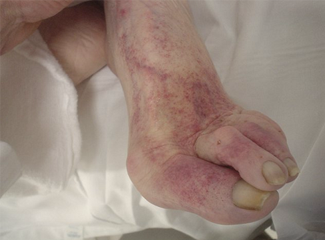- Clinical Technology
- Adult Immunization
- Hepatology
- Pediatric Immunization
- Screening
- Psychiatry
- Allergy
- Women's Health
- Cardiology
- Pediatrics
- Dermatology
- Endocrinology
- Pain Management
- Gastroenterology
- Infectious Disease
- Obesity Medicine
- Rheumatology
- Nephrology
- Neurology
- Pulmonology
Elderly Woman With Simultaneous Deep Venous and Arterial Thrombosis
This patient had unilateral petechiae on the dorsum of the left foot. If the petechiae were symmetric, the first condition on the differential diagnosis would be thrombocytopenia. Here, though, the platelet count was normal. The patient also had a duplex of both the arterial and venous systems that showed complete thrombosis of both the arterial AND venous systems.

You see an elderly woman who resides in a nursing home for a pressure sore on her left heel that has been present for the past few days. She has advanced dementia and cannot provide any useful history herself. The nursing home reports a history of hypertension and coronary arterial disease.
The patient’s vital signs are normal. Results of the head and neck examination are unremarkable; the lungs are clear and the heart beat is regular, with a 3/6 systolic ejection murmur. The abdominal exam is benign. The extremities show no cyanosis, clubbing, or edema.
The patient has a stage 1 decubitus ulcer on her left heel. Both feet feel cool and are of equal temperature. She has weak but palpable distal pulses on the good foot, but her distal pulses on the left side are not palpable and can only be heard faintly with the handheld Doppler. You note unilateral petechiae on the dorsum of the left foot (Figure). There are no other petechiae.
If the petechiae were symmetric, the first condition to consider in the differential diagnosis would be thrombocytopenia. Here, though, the platelet count was normal. The patient also had a duplex of both the arterial and venous systems that showed complete thrombosis of both the arterial AND venous systems. She was treated with heparin and both arterial and venous embolectomy, and the leg was thereby saved. The vascular surgeon was surprised that the leg was not cold initially, given the severity of the thromboses, but postulated that the deep venous thrombosis (DVT) somehow was relatively protective in the setting of such a severe arterial thrombosis.
Discussion
Petechiae are small, 1 to 2 mm, non-blanching skin lesions that are red, reddish brown, or purple. The key features are that they are new and non-blanching. They are caused by blood leaking out of the vessels, and this is the reason they do not blanch. They usually signify a new medical condition, but like a lot of examination findings, there are many possible causes (Table). Associated symptoms and location play an important role in determining the cause.
• If there is associated fever, consider an infectious process: there are many, mostly serious, infections that can be the cause. Thrombotic thrombocytopenic purpura may also be associated with fever.
• If the petechiae are predominantly on the legs, thrombocytopenia is the most likely cause.
• If the petechiae are primarily on the face and do not extend below the nipple-line, then severe coughing or vomiting or other type of Valsalva maneuver should top the list unless there is a history of a hanging or strangulation.
• If the petechiae are most prominent at areas of tight clothing, such as cuffs or waist, infection should again be considered.
In this case, the petechiae were localized to the dorsum of only one of the patient’s feet, which is quite unusual. Petechiae in the lower limbs are usually symmetric and most noticeable on the shins and calves. Localized facial petechiae occur with a hanging or a strangulation assault. Unlike most causes of petechiae that occur secondary to low platelet counts or damage to small blood vessels, the petechiae of strangulation are caused by very high venous pressures from outflow obstruction. This is likely part of the cause of the petechiae in this elderly woman. The severe DVT produced a severe obstruction to venous outflow. If and how the arterial thrombosis would have contributed to the formation of the petechiae is uncertain, however. Perhaps the combination of tissue ischemia from the arterial thrombosis and elevated venous pressure from the DVT was responsible. In addition, there was a surprising lack of edema for such extensive DVT formation; this may have been the result of decreased inflow to the leg. Regardless, keep in mind that venous thrombosis can be associated with localized petechiae.
